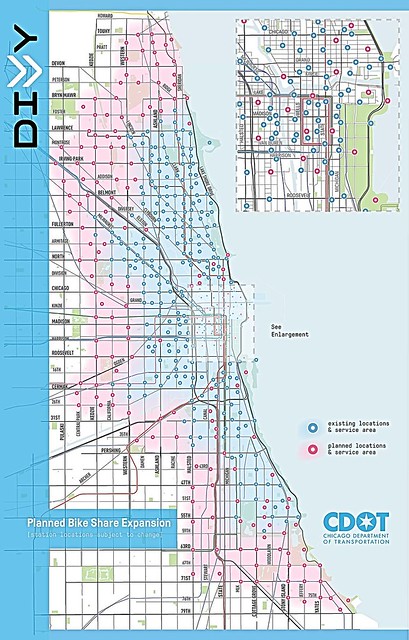
In mid-July, Alta Bicycle Share’s Mia Birk told Marketplace that, due to pipeline issues, new bikes for the systems Alta runs probably wouldn’t arrive until 2015. At the time, I predicted that the Chicago Department of Transportation would soon announce that it wouldn’t be able to expand the Divvy system from 3,000 to 4,750 cycles this year, as previously planned.
More than a month later, CDOT finally announced yesterday that Chicago won’t be getting new stations until early next spring, but they cleverly softened the blow by releasing the locations for the 175 docking stations that will be added to the existing 300. Roughly 3,100 additional docks will be added, according to Divvy general manager Elliot Greenberger.
In the news release, CDOT also boasted that, with 475 stations spread over 87 square miles and 31 wards, Divvy will have the largest number of stations and the widest coverage area of any North American city. However, New York’s Citi Bike system will still have far more bikes, with 6,000.
The delay in getting new bikes for Alta-run systems was caused by the bankruptcy of Montreal-based supplier Public Bike System Co., also known as Bixi. CDOT spokesman Pete Scales told the Chicago Tribune that the department is confident that the expansion won’t be further postponed. “Alta is in the final stages of vetting multiple supplier options, all of whom have committed to spring delivery time frames.”
Chicago’s new map of planned stations was influenced by hundreds of suggestions residents made via a station request website. The new coverage area will stretch almost to 79th Street on the South Side, as far as Touhy Avenue on the North Side, and a bit west of Pulaski Road. Infill stations will also be added downtown, and on the Near South Side, the North North Side, and in Hyde Park.
In order to ensure the system would be financially viable, CDOT officials said the first round of 300 stations was concentrated in areas with a high density of transit stops, retail, employment nodes, and other destinations. Although low-income communities like Little Village, Pilsen, Bronzeville, and Oakland did get stations, some commenters and residents argued that the system was overly focused on affluent parts of town, and that too many poor neighborhoods were overlooked.
The expansion will bring many new communities, of various income levels, into the coverage area. Some of the new neighborhoods that will be served include South Shore, Englewood, McKinley Park, Lawndale, East Garfield Park, Irving Park, Avondale, Edgewater, and Rogers Park. Although the city still hasn’t solved the problem of providing bike-share access for people who don’t have credit cards, the expansion will encourage tens of thousands of new people to use Divvy.
One drawback of the broad new coverage area is that the new districts will have a low density of stations. In most parts of the city that currently have Divvy, the stations are spaced about a quarter-mile apart, but in the new areas the stations will generally be located a half mile away from each other.
That means that users may have to walk a greater distance to check out a bike, and to get from a station to their destination. And, when there are few stations near a particular destination, an empty or full station can be a real pain in the neck. This increases the importance of rebalancing, which means more driving for Divvy staffers.
I experienced downside of sparsely spaced stations firsthand earlier this week when I rode a Divvy bike to meet a friend at Montrose Beach. The beach's sole bike-share station was at capacity so, after waiting 15 minutes for someone else to check out a bike, I gave up and pedaled almost a mile to the nearest station at Marine Drive and Junior Terrace. Needless to say, I didn't reach the beach until long after I was supposed to get there.
Hopefully, CDOT will eventually install infill stations in the new coverage areas. That will make the network more useful and cut down on the need for rebalancing.




